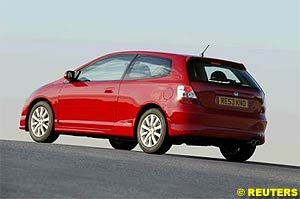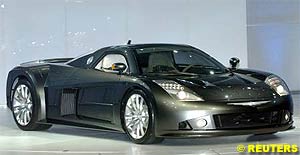

Automotive News and Reviews for the Petrolhead
Reuters Motoring Commentator
In this week's issue:
- Toyota Seeks Growth
- Civic Perception
- Chrysler Unveils New Sports Car
Toyota would be forgiven if it paused to celebrate its achievements in the United States during 2003: an eighth straight year of record sales, the title of best-selling car marquee for the first time, and a stellar launch of the youth-oriented Scion brand.
"We are downright optimistic about the future," Jim Press, executive vice president and chief operating officer of Toyota's U.S. sales arm, told a news conference at the North American auto show in Detroit. Toyota's US market share is at an all-time high - 11.7 percent in November, the latest month for which figures are available - and within reach of DaimlerChrysler's local Chrysler arm, which had 12.5 percent.
Toyota expects an even better year ahead, not only because it predicts that a stronger economy would help overall industry sales grow slightly to about 17 million units, but mostly thanks to a more robust line-up for its own brands.
With its sights set on selling more than 1.9 million cars in the US this year and two million in 2005, up from over 1.85 million in 2003, Press said Toyota would be rolling out 11 new or remodelled products in the country over the next 14 months.
The Highlander hybrid sport utility vehicle (SUV), unveiled last Sunday, will be one of them, following the second-generation Prius sedan as the second vehicle featuring its improved hybrid system. With double the power of the Prius and fuel efficiency that is better than today's average compact sedan, Toyota said it was confident the Highlander hybrid would win the hearts of mainstream American consumers when it debuts a year later.
That notion seemed to get more traction on Sunday, when the Prius was named 2003 North American Car of the Year - fitting for a car that has 16,000 back orders waiting to be filled. The auto maker also took the wraps off the FTX full-size pickup concept, a truck with a fist-like hood and muscular body which it said showed the direction of Toyota's future models in this important, high-profit segment.
"We are underperforming in this segment, with a market share of just six percent," Yukitoshi Funo, president of Toyota Motor Sales USA., told Reuters in an interview, saying the full-size pickup market presented the biggest challenge for the company. "In all the other (segments), we have 10 to 11 percent."
"We're trying to contain it at around $600 to $700 per vehicle on average, and if possible, lower it to below $500," he said. The average spending on incentives is now in the high $2,000 (1,111 pounds) level.
"Industry-wide incentives are stable or falling. The key is General Motors. If they lower theirs, then the industry may follow," he said.
One worry for Toyota is its exposure to a weaker dollar. While rivals Honda and Nissan have managed to boost their local production ratios to 90 percent and 80 percent respectively, Toyota's is still at just over 60 percent, leaving it more vulnerable to a weaker dollar.
"Surprisingly, the number hasn't changed a lot. We need to step up internal discipline to try to increase the ratio," Funo said.
Written by Chang-Ran Kim
It is a commonly held view that Britain no longer has a car industry. It isn't true.
Admittedly, the halcyon days of the Forties, Fifties and Sixties are long gone, a time when there were more British car brands than there are hours in a month, but Britain now employs more people, building more cars than ever before. It's just that we don't own any of the companies producing them.
And there is no need for balanced objectivity at this point. Remember the Austin Allegro? It was a gormless looking curio, neither a proper saloon nor a hatchback at all, which was launched amid the uncertainty of a three-day week and built to last about as long. It leaked as if designed for that very purpose, would fall apart before it had cleared the end of the production line and, inexplicably, was even fitted with a square steering wheel towards the end of its miserable life.
The Allegro was by no means an isolated incident, either, and the same strike-torn confederacy was also entrusted with incorporating four of the crown jewels of British motoring into its hapless coalition, namely Mini, Rover, Range Rover (Land Rover) and Jaguar. Today, these are the only survivors of the Leyland years and while one of them, the British-owned Rover, continues to gasp for breath, the other three are all prospering under foreign ownership. Jaguar and Range Rover, now a part of Ford, actually build cars that people can confidently buy and BMW's revival of Mini (or MINI, as it is now known) has been nothing short of a phenomenon.
Admittedly it does little for jingoistic national pride to watch as companies such as Bentley and Rolls-Royce pass quietly into foreign hands, and there are all sorts of reasons why we might rather our motoring heritage remained domestically managed. But history does suggest that we're not particularly good at it, unless it's a company making low-volume sports cars, in which case we're peerless. Caterham, Lotus, Morgan, Noble, TVR, Westfield (and more) will bear testimony to that.
But is it not of greater consequence that in addition to this particular area of expertise, thousands of skilled British workers are employed (on five day weeks) in what has now become a truly global industry anyhow. Britain is not merely a chain-gang for indigenous brands that have been pillaged from afar. With a resurgent reputation for quality and efficiency, the British workforce produces other people's cars for them too, and has been for some time. Peugeots are built in former Hillman/Chrysler/Talbot factories in Coventry. Nissan has been making cars in the North East of England for almost 20 years. Toyota employs around 3,500 people at plants in Derbyshire and North Wales. And what about the new Honda Civic? This car is built in Swindon but is also now exported back to Japan too, the country of its origin.
Honda has now divided the range in two. Three-door cars are the more sports orientated models, the five-door the more family focussed, although this categorisation is more styling related than engineering based. For all those top-of-the-range Type R dreamers who find the price of purchase and insurance just a little out of reach, there is also a new Type S version. It offers a sense of the R's more extreme performance capabilities and styling, but is also £2,500 cheaper than the flagship model, at a very sensible £13,500. Overall, the range starts from £10,000 (for the three door 1.4E) and reflecting on this from behind the wheel, it is impossible not to be impressed at how such a volume sector model can feel so well-engineered, offer acceptable levels of driving satisfaction and still represent such value-for-money. Everything is relative, of course, and I am not sure Honda has achieved the internal noise level reductions it claims, but the new Civic is still a comfortable car to drive or travel in. The range also includes a 1.7 litre diesel version.
So there you have it. Britain's lack of boardroom clout in the motor industry may be regrettable, but lamenting the fact that we no longer own any major car companies is futile. After all, did BL really deserve to survive when it built four-wheeled flotsam such as the Austin Princess (could have been designed by a seven year old), the SD1 Rover (not so much "built", more "affixed") or the Morris Ital (a risible second-generation version of the moribund Morris Marina)?
You reap what you sow, as they say, so save your tears and instead, go out and buy a decent modern British car. The new Honda Civic is well worth a look.
Betting that nothing succeeds like excess, DaimlerChrysler's Chrysler division has unveiled a muscular new sports car at Detroit's international auto show designed to tear up world speed records.
Chrysler Chief Operating Officer Wolfgang Bernhard said the high-performance prototype, dubbed the ME Four-Twelve, was powered by four turbo chargers and a massive 12-cylinder, 850 horsepower engine.
"The ME Four-Twelve has the potential to write a new chapter in the book of super sports cars," Bernhard told a news conference on Sunday. He said the top speed of the vehicle was an estimated 248 miles per hour.
Hinting that the car was something more than a mere auto show toy or "concept," and that it may actually go into production, Bernhard told automotive journalists they would have a chance to start test driving it next summer.
He did not elaborate, but Chrysler President and Chief Executive Dieter Zetsche said production of the sports car was also something more than a costly distraction for Chrysler, which has been battling to return to long-term profits.
"The bottom line is defined by both costs and revenues, and revenues are very much defined by emotions," Zetsche said. "You need to make people dream of your cars and then you're better off than if you save a few hundred bucks elsewhere."
Separately, Zetsche announced on the sidelines of the show that Chrysler's Dodge brand will soon put its Viper SRT-10 sports car on sale in Europe. Zetsche said in a statement European sales of other Chrysler Group vehicles would follow, more than doubling the total number available outside North America in the next four years.
A new flagship rear-wheel-drive sedan, the 300C, is among new products Chrysler is unveiling this week in Detroit, which plays host to the auto industry's leading annual show.
Before rolling out the ME Four-Twelve, Chrysler and its Jeep brand also unveiled a military-inspired vehicle called the Jeep Rescue. The off-roader, every bit as massive as a Hummer from Chrysler's cross-town rival General Motors, was touted as "the ultimate search-and-rescue vehicle" by Chrysler design chief Trevor Creed.
![]() Toyota Seeks Growth
Toyota Seeks Growth
 Instead, the world's third-biggest auto maker is already talking about surpassing the record sales figure this year and next, stating two main reasons: hybrids and pickup trucks.
Instead, the world's third-biggest auto maker is already talking about surpassing the record sales figure this year and next, stating two main reasons: hybrids and pickup trucks.
 But Funo added that with the start of its San Antonio, Texas plant in 2006, Toyota would pile on 150,000 units in sales of the vehicles, doubling its market share in the segment to about 12 percent. Funo said Toyota would also work to improve profitability by keeping its spending on sales incentives such as discounts and rebates relatively low.
But Funo added that with the start of its San Antonio, Texas plant in 2006, Toyota would pile on 150,000 units in sales of the vehicles, doubling its market share in the segment to about 12 percent. Funo said Toyota would also work to improve profitability by keeping its spending on sales incentives such as discounts and rebates relatively low.
![]() Civic Perception
Civic Perception
 It was in the Seventies that things started to go badly wrong, the era when manufacturing ownership began to slip from our grasp. Most of the surviving famous British companies, names like Morris, Riley and Triumph, were swallowed-up by a nationalised monster called British Leyland, a process that finally ground to a halt in the early Eighties. This laughable corporation toiled against regular and bitter union insurrection while its design department (pah!) created some of the most mercilessly, but justifiably, mocked shockers in automotive history.
It was in the Seventies that things started to go badly wrong, the era when manufacturing ownership began to slip from our grasp. Most of the surviving famous British companies, names like Morris, Riley and Triumph, were swallowed-up by a nationalised monster called British Leyland, a process that finally ground to a halt in the early Eighties. This laughable corporation toiled against regular and bitter union insurrection while its design department (pah!) created some of the most mercilessly, but justifiably, mocked shockers in automotive history.
 And I'm not surprised they want it back either, it's a splendid car. Inside and out, Honda has made more than 3,000 changes over the outgoing model in the pursuit of greater refinement and quality, together with improved driving enjoyment. All the designers' good work has been faithfully translated (by British hands!) into the finished product. Even standard models offer the driver a real sense of purpose from behind the wheel. Everything imbues a sense of having been properly engineered and constructed in true Honda style; the stiffer bodyshell, lowered ride height and a range of suspension modifications sharpen-up the handling noticeably and behind the safe, almost humble exterior, a willing performer quietly exists. Across the entire petrol-engined range (1.4, 1.6 and 2.0 variants), the Civic is the faster, more economical car compared to its direct Ford Focus, Peugeot 307 and Renault Megane rivals and yet it also tends to be several hundred pounds cheaper too.
And I'm not surprised they want it back either, it's a splendid car. Inside and out, Honda has made more than 3,000 changes over the outgoing model in the pursuit of greater refinement and quality, together with improved driving enjoyment. All the designers' good work has been faithfully translated (by British hands!) into the finished product. Even standard models offer the driver a real sense of purpose from behind the wheel. Everything imbues a sense of having been properly engineered and constructed in true Honda style; the stiffer bodyshell, lowered ride height and a range of suspension modifications sharpen-up the handling noticeably and behind the safe, almost humble exterior, a willing performer quietly exists. Across the entire petrol-engined range (1.4, 1.6 and 2.0 variants), the Civic is the faster, more economical car compared to its direct Ford Focus, Peugeot 307 and Renault Megane rivals and yet it also tends to be several hundred pounds cheaper too.
![]() Chrysler Unveils New Sports Car
Chrysler Unveils New Sports Car
 "We expect a zero-to-60 time of 2.9 seconds," Bernhard added, saying that would make it the first sports car ever to break the three-second barrier.
"We expect a zero-to-60 time of 2.9 seconds," Bernhard added, saying that would make it the first sports car ever to break the three-second barrier.
© 2007 autosport.com . This service is provided under the Atlas F1 terms and conditions.
|
Volume 10, Issue 01
Articles
Williams Launch: Reading Between the Lines
Ugly is Beautiful for Williams
Technical Analysis: Dissecting the Walrus
Interview with Hermann Tilke
2004 Countdown: Facts & Stats
Columns
The Fuel Stop
On the Road
Elsewhere in Racing
> Homepage |